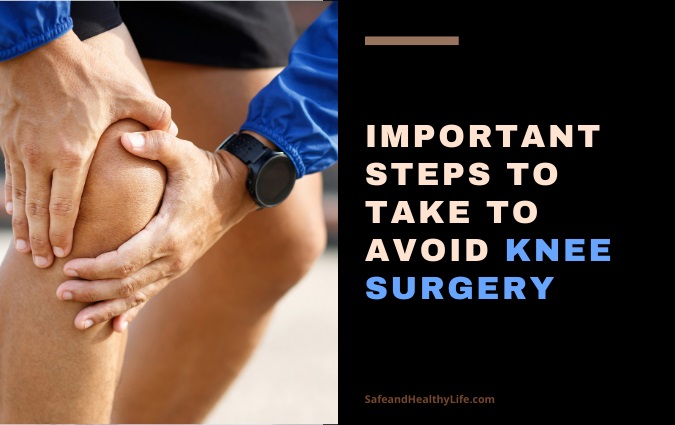
Knees…an often overused, abused joint we depend on for most of our daily movements can cause us extreme amounts of pain if not taken care of properly.
We use our knees for mundane movements like walking to acting as shock absorbers for the rest of our body when experiencing impact. They allow us to exercise and perform fun tasks like dancing, bicycling, playing with kids, sports and so much more.
Without proper care, we can overuse and injure these important joints. But with modern medicine, we know knee surgery is an option – from a knee scope to remove arthritic tissue or repair tendon or ligament tears, to a complete knee replacement.
Why not just move to surgery right away – why should we try to avoid it as long as possible?
There’s actually a number of reasons to try to avoid surgery for as long as possible, and with some tips, we can help you stay active and away from the surgeon as long as possible.
Knowing how to address knee issues before they become more serious (to the point of requiring surgery!) is essential to keeping you active and moving.
While many of us would happily do anything to stay out from under the knife, with modern medicine having the capability to fix so much, it can be tempting for some to just ‘keep on keeping on’ with painful knees until it gets to be too late and surgery is the only option. But there’s a lot of reasons to try to avoid surgery.
One of the bigger reasons?
Surgery ain’t cheap! With an average cost of total knee surgery in the US coming to around $57,000, cost alone can be a good reason for trying all other alternatives to relieving joint issues.
Compare that to the average price of a quality knee brace between $50-150 depending on the level of support, taking the time to read some knee compression sleeve reviews can save a lot of coin in your wallet! But what about other knee surgeries?
Arthroscopy (commonly referred to simply as a ‘scope’) is a surgical technique used for a variety of different knee issues. This procedure involves a thin instrument with a camera at one end, and this is threaded through a small incision.
The camera guides the surgeon’s work. Arthroscopy is often a procedure used to help prevent the need for more invasive surgeries, including knee replacement. It can be an effective tool in preventing the need for a replacement, but it’s still invasive (and can be costly as well).
Scopes can be used for a variety of knee issues including reconstruction of ligaments and the meniscus, removal of inflamed or damaged tissue, or removing fragments of cartilage and bone due to an injury.

Photo Credit: Unsplash
Not only is there an upfront cost to surgery, but you also have secondary costs involving the time off work that you may need.
Some surgeries won’t require weeks off work, but a knee replacement, you could need as much as several MONTHS off work to heal. Depending on your paid time off the bank, this might be a real hardship for you.
And time off work is a big deal, but you have other non-monetary costs too. The time that you’re laid up can be a real issue for many individuals.
Being unable to care for others like children 100% can be frustrating, or simply being unable to take care of basic needs like cooking for yourself or cleaning up, doing laundry, etc can require the need of a caregiver (paid or volunteer).
Other non-financial costs can be side effects and no guarantees on the success of the surgery.
Fortunately for many individuals recovery is relatively easy, but complications can arise resulting in much longer convalescence and recuperation periods.
In approximately 2% of all knee surgeries in the US, permanent complications can arise, affecting the individual’s mobility for the rest of their lives.
Finally, the reality is the biggest side effect you may have is permanent movement restrictions. There’s a reason even surgeons recommend preventing and holding off on surgery for as long as possible.
Even with the most successful of surgeries, a knee replacement will require modified movement for the rest of your life. Often, exercise restrictions are put in place (such as no running or jumping, depending on the surgeon’s recommendation).
Very often, individuals will never regain full range of motion from a pre-surgery standpoint. The pain relief surgery provides can certainly make the procedure worth it, but side effects need to be considered.
There’s a long list of great recommendations for helping delay surgery for as long as possible.
- Lose Weight – every pound lost equates to four pounds less pressure on the knees
- Build up leg strength – leg strengthening exercises can help support knees better
- Rest – if injured, sometimes some rest can allow the body to heal itself
- Brace – find a good knee brace to help provide external support and relieve inflammation.
- Cortisone injections – cortical steroids can help reduce inflammation, improving the body’s healing capabilities
- Acupuncture or dry needling – these two modalities also work to help the body repair itself
- OTC medications – simple over the counter pain relievers and anti-inflammatories can go a long way in healing mild injuries
- Physical therapy – for more intense injuries, PT is a great way to help strengthen and heal an injury
- Dietary supplements – supplements such as glucosamine and collagen can help the body repair from within
Surgery can be a godsend for those with extreme pain and for whom other techniques have been unsuccessful – with a good surgeon and the appropriate procedure, quality of life can be greatly improved. But avoiding that for as long as possible is imperative – so keep these tips in mind!
About The Author:
Susan Melony is a freelance writer, digital marketer, and entrepreneur based in Kansas City. She often travels while working, and is passionate about the digital nomad lifestyle.


![[Infographic] What Steps to Take After a Car Accident Infographic](https://www.safeandhealthylife.com/wp-content/uploads/2017/03/Infographic.png)

